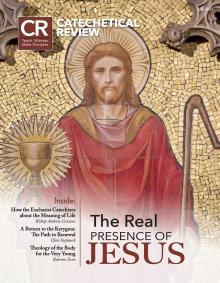In the book Speaking the Truth in Love, Dr. Petroc Willey offers a triadic framework for transmitting the faith: the heart, head, and hand, where hand is the process of “handing on” the Deposit of Faith.[1] I hope he won’t mind if I borrow this triadic framework and modify it slightly for teaching St. John Paul II’s theology of the body (TOB) to the very young by changing “hand” to refer to “hands-on teaching,” i.e., manipulatives. In this way, all three—head, heart, and hand—can come together in forming the young child’s Trinitarian-Catholic identity.
A Mini-Scripture Study
Where did my inspiration for teaching young children TOB arise from? It started with my son, Michael, at age ten. We were sitting at the dinner table, and the parental catechist in me decided to take him through a mini-Scripture study of Genesis 1 and 2. We started with Genesis 1:27 about being made in God’s image and likeness; then continued with Genesis 2:7, on imaging God by being both body and spirit; and capped it off with Genesis 2:23–24 with an explanation of how we’re made for union and communion through a gift of self.
His ten-year-old eyes immediately told me I’d overshot his ability to comprehend. So, I grabbed what I had at hand, my hands, and created my first TOB visual aid: I put my hands together in a prayer position and said, “We’re made from one nature” and then I dropped both hands down with two fingers protruding from each hand (like two legs) “embodied in two ways”, then interlaced my fingers while saying “for the purpose of union and communion” and turned my hands outward as if giving a gift and said with a triumphant finish “through a sincere gift of self!” By George, I think he got it! I’d “handed on” a critical portion of the faith in a seminal way to a ten-year-old.
Twenty-four years later, I’ve graduated from merely using my hands (although I’ve taught thousands of people this “gift formula” using the hand motions) to a bevy of visual aids that can double as manipulatives for preschool age. And my favorite among them are gift bows. But just how young can we begin to teach TOB? Enter my one-year-old granddaughter, Sutton.
The rest of this online article is available for current Guild members.
This article is from The Catechetical Review (Online Edition ISSN 2379-6324) and may be copied for catechetical purposes only. It may not be reprinted in another published work without the permission of The Catechetical Review by contacting [email protected]


















